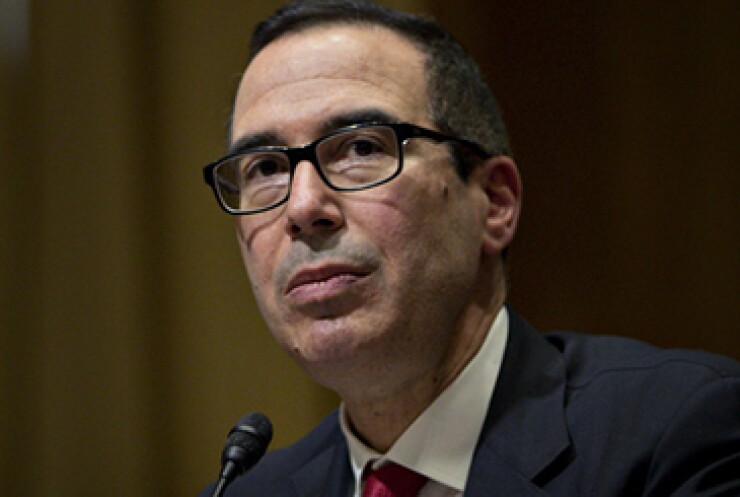
A federal appeals court ruling has opened the door for litigants to challenge a 2012 decision by the U.S. government to sweep all of Fannie Mae and Freddie Mac's profits into the coffers of the Treasury Department.
This week’s ruling will allow mutual fund manager Fairholme Funds and shareholders represented by Investors Unite to review 48 previously secret government documents related to the profit sweep decision.
The ruling could also give the investors in Fannie and Freddie legal leverage to force the Treasury Department and Federal Housing Finance Agency to release additional documents. The group is seeking more than 10,000 sealed documents.
"GSE shareholders secured a notable procedural victory in Fairholme v. U.S.," said Isaac Boltansky, a Washington policy analyst at Compass Point Research and Trading. "We believe that this decision should be viewed positively for shareholders and our sense remains that the odds of a GSE shareholder settlement have increased since the election."
Bose George, a managing director at Keefe, Bruyette and Woods, agreed.
"It is clearly a win for plaintiffs," he said. "Now we have to see the documents."
The next question involves the mechanism for reviewing the documents and the timeline for their release. He expects the information gleamed from the documents "will reflect poorly on the government's motives."
The investors praised the decision.
"It is clear from the Court of Appeals' unanimous ruling that the vast bulk of the 11,000 documents withheld by the government will now have to be disclosed to the plaintiffs and the courts, and we are confident that these documents will further discredit the government’s defense narrative," said Charles Cooper, a partner at the Cooper & Kirk, who argued the case before the appeals court.
A Treasury spokesperson declined to comment.
Fannie and Freddie were placed into conservatorship in 2008 due to rising losses and to maintain a functioning secondary mortgage market. The two government-sponsored enterprises began becoming profitable again a few years later, spurring the Treasury Department to seize their profits in August 2012.
The move riled GSE shareholders who view the profit sweep as an illegal "taking" of property. But their efforts to pursue their claims have been rebuffed by several U.S. district courts.
From 2008 to through 2012, Freddie took $71.3 billion in draws from the U.S. Treasury to stay afloat. From 2008 and through the third quarter of 2016, Freddie has remitted $101.4 billion in profits to Treasury.
Fannie followed a similar course, tapping Treasury for $116.1 billion in cumulative draws from 2008 to 2011 and paying back $151.4 billion to Treasury. Fannie has not taken a draw from Treasury since 2011 and Freddie has not taken a draw since 2012.
These quarterly profit sweeps, which remain ongoing, have allowed FHFA to pursue its plans to downsize Fannie and Freddie. It also relieved the two GSEs of paying a 10% dividend to Treasury under a prior conservatorship agreement.
Monday's decision by the Federal Court of Appeals only orders government attorneys to release 48 of 56 documents requested by the investors' attorneys. But the litigants see it as a major victory as they return to the U.S. Claims Court to pursue their case.
Meanwhile, the change in administrations might affect Treasury's approach to the shareholders litigation. Treasury Secretary-designate Steven Mnuchin had invested in a hedge fund that holds GSE stock and stands to benefit from any government settlement. Mnuchin said he has divested his interest in that fund.
"I have tremendous expertise on the entities," he said at his confirmation hearing. "As it relates to the legal case of various holders of securities. I haven't studied that at all."
Still, observers said the change in administrations undoubtedly helps GSE investors.
Obama administration appointees were going to do "everything they could to stonewall the shareholders and drag this out in the courts," said Ed Mills, a Washington policy analyst at FBR Capital Markets. "I don't know exactly what Treasury is going to do. But they are not going to stonewall the shareholders or fight this as vigorously as the Obama administration Treasury Department did."
Meanwhile, attorneys for the GSE investors have been interviewing government and GSE persons involved in the profit sweep arrangement.
As more documents are released, the attorneys are hoping to bolster their case that the government knew Fannie and Freddie would be profitable and sought to improperly redirect those funds to the government.
They deposed Susan McFarland, Fannie's chief financial officer at the time of the profit sweep, who told government officials that Fannie’s financial outlook was getting better and "we would be able to deliver sustainable profits over time."
If that improvement continued, the former CFO estimated Fannie probably would be able to recognize around $50 billion on deferred tax assets sometime in mid-2013, she said. [A deferred tax asset is an asset on a company's balance sheet that may be used to reduce any subsequent period's income tax expense.]
When the profit sweep was announced, "it was probably a desire not to allow capital to build up within the enterprises and not to allow the enterprises to recapitalize themselves," McFarland said, according to the deposition.





